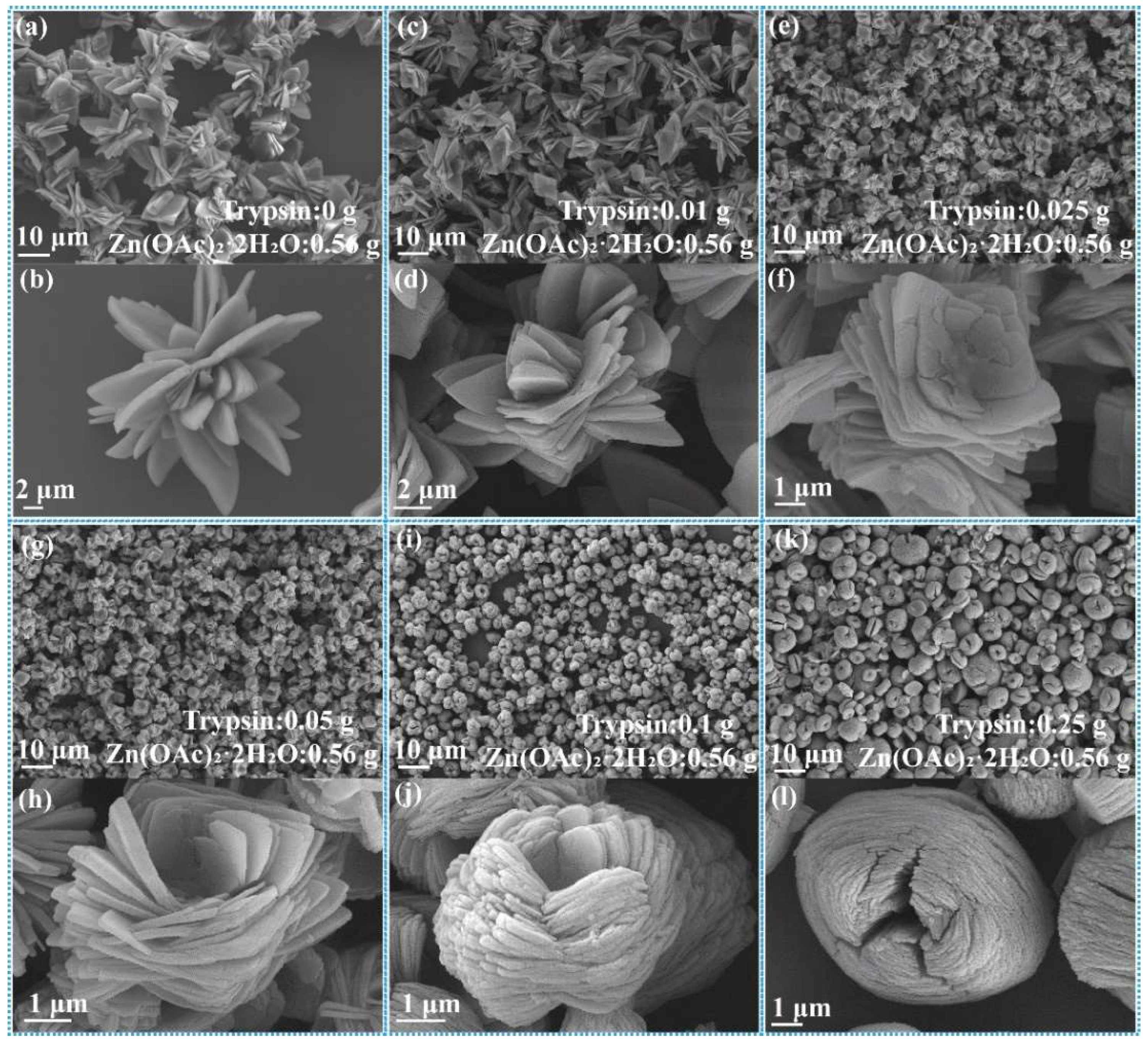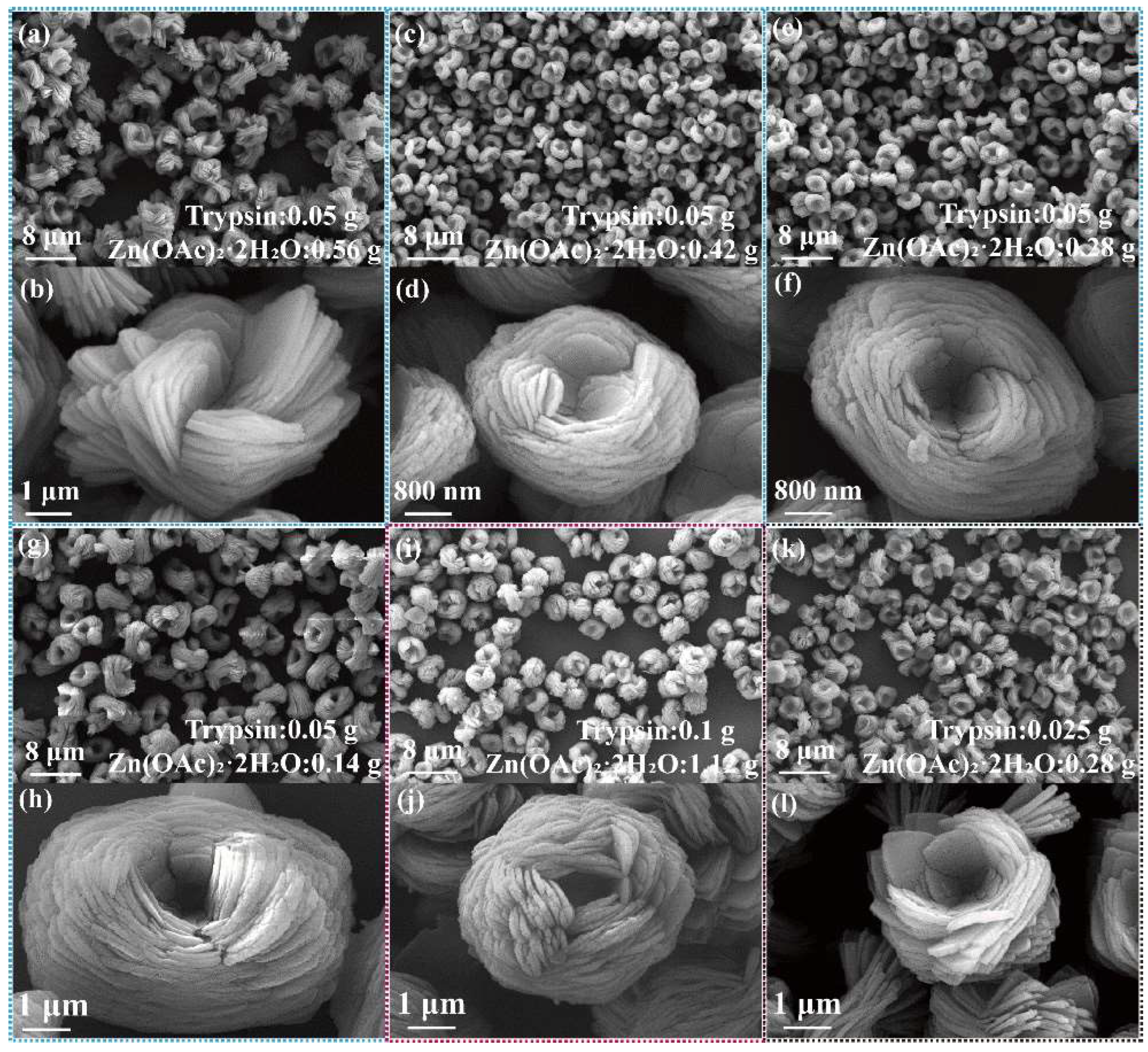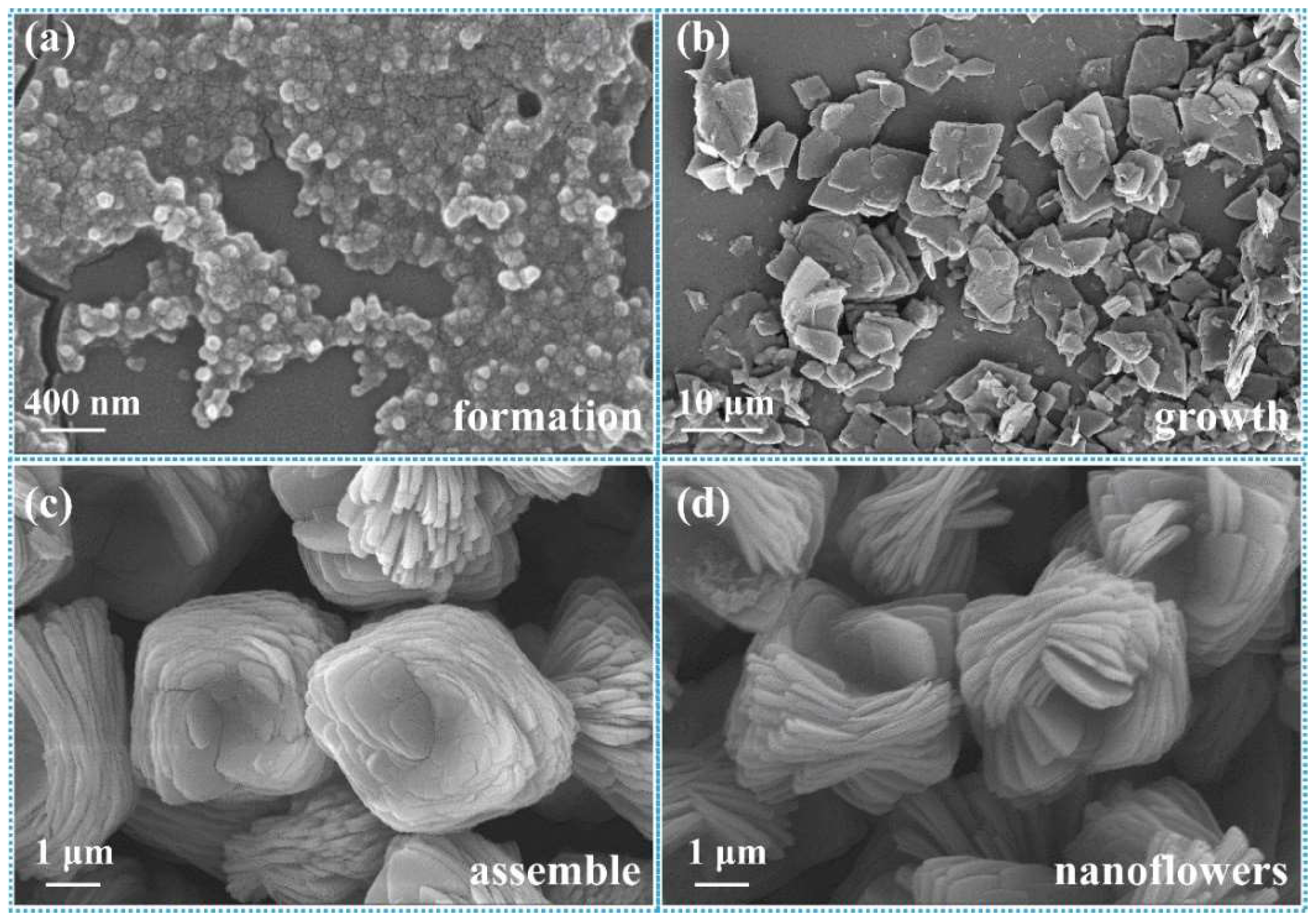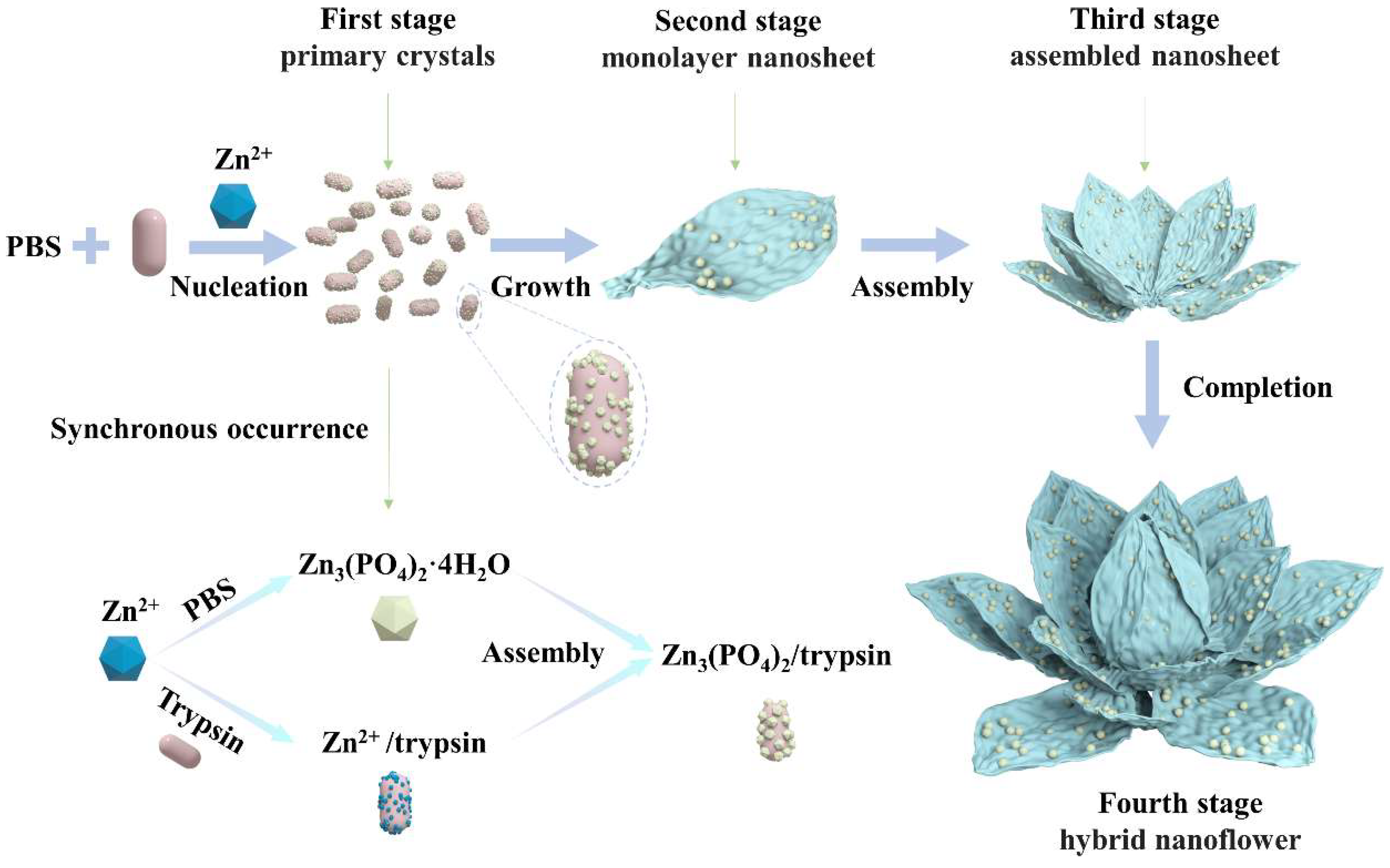Trypsin/Zn3(PO4)2 Hybrid Nanoflowers: Controlled Synthesis and Excellent Performance as an Immobilized Enzyme
Abstract
1. Introduction
2. Result and Discussion
2.1. Structural Characteristics of Hybrid Nanoflowers
2.2. Controlled Synthesis of Hybrid Nanoflowers
2.3. Formation Mechanism of Trypsin/Zn3(PO4)2 Hybrid Nanoflowers
2.4. Enzyme Activity of Trypsin/Zn3(PO4)2 Hybrid Nanoflowers
3. Methods and Materials
3.1. Materials
3.2. Preparation of the PBS Buffer
3.3. Synthesis of Trypsin/Zn3(PO4)2 Hybrid Nanoflowers
3.4. Activity Assays of Free Trypsin and Trypsin/Zn3(PO4)2
3.5. Characterization
4. Conclusions
Supplementary Materials
Author Contributions
Funding
Institutional Review Board Statement
Informed Consent Statement
Data Availability Statement
Acknowledgments
Conflicts of Interest
References
- Ge, J.; Lei, J.; Zare, R.N. Protein–inorganic hybrid nanoflowers. Nat. Nanotechnol. 2012, 7, 428–432. [Google Scholar] [CrossRef] [PubMed]
- Liu, Y.; Ji, X.; He, Z. Organic–inorganic nanoflowers: From design strategy to biomedical applications. Nanoscale 2019, 11, 17179–17194. [Google Scholar] [CrossRef]
- Shcharbin, D.; Halets-Bui, I.; Abashkin, V.; Dzmitruk, V.; Loznikova, S.; Odabaşı, M.; Acet, Ö.; Önal, B.; Özdemir, N.; Shcharbina, N. Hybrid metal-organic nanoflowers and their application in biotechnology and medicine. Colloids Surf. B Biointerfaces 2019, 182, 110354. [Google Scholar] [CrossRef] [PubMed]
- Thawari, A.G.; Rao, C.P. Peroxidase-like catalytic activity of copper-mediated protein–inorganic hybrid nanoflowers and nanofibers of β-lactoglobulin and α-lactalbumin: Synthesis, spectral characterization, microscopic features, and catalytic activity. ACS Appl. Mater. Interfaces 2016, 8, 10392–10402. [Google Scholar] [CrossRef] [PubMed]
- Kamil, M.; Ko, Y. Electrochemically Stable and Catalytically Active Coatings Based on Self-Assembly of Protein-Inorganic Nanoflowers on Plasma-Electrolyzed Platform. ACS Appl. Mater. Interfaces 2021, 13, 39854–39867. [Google Scholar] [CrossRef]
- Zhang, M.; Zhang, Y.; Yang, C.; Ma, C.; Tang, J. Enzyme-inorganic hybrid nanoflowers: Classification, synthesis, functionalization and potential applications. Chem. Eng. J. 2021, 415, 129075. [Google Scholar] [CrossRef]
- Zhu, J.; Wen, M.; Wen, W.; Du, D.; Zhang, X.; Wang, S.; Lin, Y. Recent progress in biosensors based on organic-inorganic hybrid nanoflowers. Biosens. Bioelectron. 2018, 120, 175–187. [Google Scholar] [CrossRef]
- Kiani, M.; Mojtabavi, S.; Jafari-Nodoushan, H.; Tabib, S.-R.; Hassannejad, N.; Faramarzi, M.A. Fast anisotropic growth of the biomineralized zinc phosphate nanocrystals for a facile and instant construction of laccase@ Zn3 (PO4) 2 hybrid nanoflowers. Int. J. Biol. Macromol. 2022, 204, 520–531. [Google Scholar] [CrossRef]
- Nag, R.; Rao, C.P. Development and demonstration of functionalized inorganic–organic hybrid copper phosphate nanoflowers for mimicking the oxidative reactions of metalloenzymes by working as a nanozyme. J. Mater. Chem. B 2021, 9, 3523–3532. [Google Scholar] [CrossRef]
- Cheon, H.J.; Adhikari, M.D.; Chung, M.; Tran, T.D.; Kim, J.; Kim, M.I. Magnetic nanoparticles-embedded enzyme-inorganic hybrid nanoflowers with enhanced peroxidase-like activity and substrate channeling for glucose biosensing. Adv. Healthc. Mater. 2019, 8, 1801507. [Google Scholar] [CrossRef]
- Liu, Y.; Zhang, Y.; Li, X.; Yuan, Q.; Liang, H. Self-repairing metal–organic hybrid complexes for reinforcing immobilized chloroperoxidase reusability. Chem. Commun. 2017, 53, 3216–3219. [Google Scholar] [CrossRef] [PubMed]
- Zhao, F.; Wang, Q.; Dong, J.; Xian, M.; Yu, J.; Yin, H.; Chang, Z.; Mu, X.; Hou, T.; Wang, J. Enzyme-inorganic nanoflowers/alginate microbeads: An enzyme immobilization system and its potential application. Process Biochem. 2017, 57, 87–94. [Google Scholar] [CrossRef]
- Rai, S.K.; Narnoliya, L.K.; Sangwan, R.S.; Yadav, S.K. Self-assembled hybrid nanoflowers of manganese phosphate and L-arabinose isomerase: A stable and recyclable nanobiocatalyst for equilibrium level conversion of D-galactose to D-tagatose. ACS Sustain. Chem. Eng. 2018, 6, 6296–6304. [Google Scholar] [CrossRef]
- Zhao, H.; Lv, J.; Li, F.; Zhang, Z.; Zhang, C.; Gu, Z.; Yang, D. Enzymatical biomineralization of DNA nanoflowers mediated by manganese ions for tumor site activated magnetic resonance imaging. Biomaterials 2021, 268, 120591. [Google Scholar] [CrossRef]
- Lao, J.; Li, D.; Jiang, C.; Luo, C.; Qi, R.; Lin, H.; Huang, R.; Waterhouse, G.I.; Peng, H. Synergistic effect of cobalt boride nanoparticles on MoS 2 nanoflowers for a highly efficient hydrogen evolution reaction in alkaline media. Nanoscale 2020, 12, 10158–10165. [Google Scholar] [CrossRef]
- Zhang, X.; Li, B.; Lan, M.; Yang, S.; Xie, Q.; Xiao, J.; Xiao, F.; Wang, S. Cation modulation of cobalt sulfide supported by mesopore-rich hydrangea-like carbon nanoflower for oxygen electrocatalysis. ACS Appl. Mater. Interfaces 2021, 13, 18683–18692. [Google Scholar] [CrossRef]
- Li, P.; Zheng, J.; Xu, J.; Zhang, M. Keratin-inorganic hybrid nanoflowers decorated with Fe 3 O 4 nanoparticles as enzyme mimics for colorimetric detection of glucose. Dalton Trans. 2021, 50, 14753–14761. [Google Scholar] [CrossRef]
- Zhai, C.; Miao, L.; Zhang, Y.; Zhang, L.; Li, H.; Zhang, S. An enzyme response-regulated colorimetric assay for pattern recognition sensing application using biomimetic inorganic-protein hybrid nanoflowers. Chem. Eng. J. 2022, 431, 134107. [Google Scholar] [CrossRef]
- Pan, W.; Jiang, T.; Lu, T.; Jin, Q.; Xi, Y.; Zhang, W. Biomimetic-mineralized bifunctional nanoflowers for enzyme-free and colorimetric immunological detection of protein biomarker. Talanta 2022, 238, 123001. [Google Scholar] [CrossRef]
- Talens-Perales, D.; Fabra, M.J.; Martínez-Argente, L.; Marín-Navarro, J.; Polaina, J. Recyclable thermophilic hybrid protein-inorganic nanoflowers for the hydrolysis of milk lactose. Int. J. Biol. Macromol. 2020, 151, 602–608. [Google Scholar] [CrossRef]
- He, W.; Qiao, B.; Li, F.; Pan, L.; Chen, D.; Cao, Y.; Tu, J.; Wang, X.; Lv, C.; Wu, Q. A novel electrochemical biosensor for ultrasensitive Hg 2+ detection via a triple signal amplification strategy. Chem. Commun. 2021, 57, 619–622. [Google Scholar] [CrossRef] [PubMed]
- Findik, M.; Bingol, H.; Erdem, A. Electrochemical detection of interaction between daunorubicin and DNA by hybrid nanoflowers modified graphite electrodes. Sens. Actuators B Chem. 2021, 329, 129120. [Google Scholar] [CrossRef]
- Zhang, M.; Zhang, Y.; Yang, C.; Ma, C.; Tang, J. A smartphone-assisted portable biosensor using laccase-mineral hybrid microflowers for colorimetric determination of epinephrine. Talanta 2021, 224, 121840. [Google Scholar] [CrossRef] [PubMed]
- Sun, T.; Fu, M.; Xing, J.; Ge, Z. Magnetic nanoparticles encapsulated laccase nanoflowers: Evaluation of enzymatic activity and reusability for degradation of malachite green. Water Sci. Technol. 2020, 81, 29–39. [Google Scholar] [CrossRef]
- Maurya, S.S.; Nadar, S.S.; Rathod, V.K. Dual activity of laccase-lysine hybrid organic–inorganic nanoflowers for dye decolourization. Environ. Technol. Innov. 2020, 19, 100798. [Google Scholar] [CrossRef]
- Zhou, S.; Wang, L.; Chen, X.; Guan, X. Label-free nanopore single-molecule measurement of trypsin activity. ACS Sens. 2016, 1, 607–613. [Google Scholar] [CrossRef] [PubMed]
- Deng, Y.; Deng, C.; Qi, D.; Liu, C.; Liu, J.; Zhang, X.; Zhao, D. Synthesis of core/shell colloidal magnetic zeolite microspheres for the immobilization of trypsin. Adv. Mater. 2009, 21, 1377–1382. [Google Scholar] [CrossRef]
- Dong, J.; Ning, W.; Liu, W.; Bruening, M.L. Limited proteolysis in porous membrane reactors containing immobilized trypsin. Analyst 2017, 142, 2578–2586. [Google Scholar] [CrossRef]
- Thill, A.S.; Figueiredo, W.T.; Lobato, F.O.; Vaz, M.O.; Fernandes, W.P.; Carvalho, V.E.; Soares, E.A.; Poletto, F.; Teixeira, S.R.; Bernardi, F. New horizons in photocatalysis: The importance of mesopores for cerium oxide. J. Mater. Chem. A 2020, 8, 24752–24762. [Google Scholar] [CrossRef]
- Aslani, E.; Abri, A.; Pazhang, M. Immobilization of trypsin onto Fe3O4@ SiO2–NH2 and study of its activity and stability. Colloids Surf. B Biointerfaces 2018, 170, 553–562. [Google Scholar] [CrossRef]
- Zhao, L.; Wang, T.; Wu, Q.; Liu, Y.; Chen, Z.; Li, X. Fluorescent strips of electrospun fibers for ratiometric sensing of serum heparin and urine trypsin. ACS Appl. Mater. Interfaces 2017, 9, 3400–3410. [Google Scholar] [CrossRef] [PubMed]
- Zhou, J.; Zhang, F.; Zhao, R.; Liu, S.; Li, W.; He, F.; Gai, S.; Yang, P. A novel “off-on-off” fluorescent sensor based on inner filter effect for ultrasensitive detection of protamine/trypsin and subcellular colocalization. Sens. Actuators B Chem. 2021, 340, 129930. [Google Scholar] [CrossRef]
- Zhong, C.; Yang, B.; Huang, W.; Huang, H.; Zhang, S.; Yan, X.; Lu, Q.; Chen, Z.; Lin, Z. Self-assembly synthes is of trypsin-immobilized monolithic microreactor for fast and efficient proteolysis. J. Chromatogr. A 2021, 1635, 461742. [Google Scholar] [CrossRef] [PubMed]
- Zhang, B.; Li, P.; Zhang, H.; Li, X.; Tian, L.; Zhang, Q. Preparation of lipase/Zn3 (PO4) 2 hybrid nanoflower and its catalytic performance as an immobilized enzyme. Chem. Eng. J. 2016, 291, 287–297. [Google Scholar] [CrossRef]






Publisher’s Note: MDPI stays neutral with regard to jurisdictional claims in published maps and institutional affiliations. |
© 2022 by the authors. Licensee MDPI, Basel, Switzerland. This article is an open access article distributed under the terms and conditions of the Creative Commons Attribution (CC BY) license (https://creativecommons.org/licenses/by/4.0/).
Share and Cite
Wang, Z.; Liu, P.; Fang, Z.; Jiang, H. Trypsin/Zn3(PO4)2 Hybrid Nanoflowers: Controlled Synthesis and Excellent Performance as an Immobilized Enzyme. Int. J. Mol. Sci. 2022, 23, 11853. https://doi.org/10.3390/ijms231911853
Wang Z, Liu P, Fang Z, Jiang H. Trypsin/Zn3(PO4)2 Hybrid Nanoflowers: Controlled Synthesis and Excellent Performance as an Immobilized Enzyme. International Journal of Molecular Sciences. 2022; 23(19):11853. https://doi.org/10.3390/ijms231911853
Chicago/Turabian StyleWang, Zichao, Pei Liu, Ziyi Fang, and He Jiang. 2022. "Trypsin/Zn3(PO4)2 Hybrid Nanoflowers: Controlled Synthesis and Excellent Performance as an Immobilized Enzyme" International Journal of Molecular Sciences 23, no. 19: 11853. https://doi.org/10.3390/ijms231911853
APA StyleWang, Z., Liu, P., Fang, Z., & Jiang, H. (2022). Trypsin/Zn3(PO4)2 Hybrid Nanoflowers: Controlled Synthesis and Excellent Performance as an Immobilized Enzyme. International Journal of Molecular Sciences, 23(19), 11853. https://doi.org/10.3390/ijms231911853





